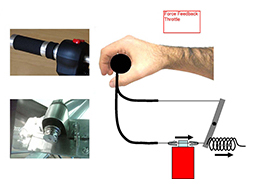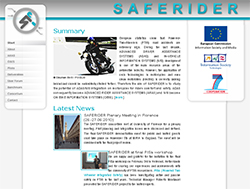 Right To Ride says that you can now support us against the “Throttle Control” of motorcycles on Facebook.
Right To Ride says that you can now support us against the “Throttle Control” of motorcycles on Facebook.
As previously reported, “EVSC (Electronic Vehicle Speed Control) is back with a vengeance through the re-introduction of the Intelligent Speed Adaptation (ISA) – or – speed control system in a European Union (EU) Commission funded project called “Saferider”.
Of the five warning systems being developed in the project, the Force Feedback Throttle is the most dangerous.
When the bike enters a lower speed limited zone (e.g. riding from a 40mph limit through to a 30mph limit without slowing down) then the force feedback throttle will warn the rider that the bike is travelling too fast.
The throttle reacts by resisting the rider when trying to accelerate. When the correct speed is reached, the throttle returns to full control of the rider.
Throttle control is not all about speed, there appears to be a mistaken belief that, “The throttle on a motorcycle only makes bikes go faster and therefore safety can be improved simply by closing the throttle and slowing things down.”
Motorcycle trainer, Duncan MacKillop, says “The primary function of the throttle is to turn our bikes from something that is statically unstable to something that is statically and dynamically stable.”
 “The secondary function of the throttle is to control our suspension. Most riders know that the forks extend when we open the throttle (..). Few riders appreciate that the rear suspension also extends when we open the throttle. This extension of the suspension when we open the throttle gives us lots more ground clearance which is essential in any corner as well as putting the suspension in its sweet spot.”
“The secondary function of the throttle is to control our suspension. Most riders know that the forks extend when we open the throttle (..). Few riders appreciate that the rear suspension also extends when we open the throttle. This extension of the suspension when we open the throttle gives us lots more ground clearance which is essential in any corner as well as putting the suspension in its sweet spot.”
“Finally, the throttle does the relatively simple job of changing the speed of the bike. With an open throttle, a bike is more stable, has better ground clearance and has improved suspension function. With a closed throttle a bike is less stable, has less ground clearance and reduced suspension function. Of these two states, which is the safest?”
As riders we may not understand all the technicalities of the link between the throttle and the control and stability of the bike, but what we do know is that the balance of riding, accelerating, braking and cornering on a motorcycle requires full control of the motorcycle without interference with the throttle.
Saferider
We have written directly and presented a paper to the EU Commission Project Officer and Directors of the SAFERIDER project, setting out the reasons why we consider the Force Feedback Throttle dangerous.
Our argument in this paper is that any interference with the throttle will de-stabilize the motorcycle and place the rider in a precarious situation. We set out our reasons in detail why the development of this device – the force feedback throttle – must be stopped immediately and withdrawn from the SAFERIDER project.
![]() The “Saferider” project has a myriad of partners which includes the Federation of European Motorcyclists Associations (FEMA), made up of 25 rider organizations across Europe, including the the BMF (British Motorcyclists Federation) and MAG (Motorcycle Action Group UK) from the UK.
The “Saferider” project has a myriad of partners which includes the Federation of European Motorcyclists Associations (FEMA), made up of 25 rider organizations across Europe, including the the BMF (British Motorcyclists Federation) and MAG (Motorcycle Action Group UK) from the UK.
Riders Organisations
The purpose of FEMA’s involvement in the project was to ensure that any device developed in the project would not take control away from the rider and this was made clear at the SAFERIDER User Forum by the former FEMA President Hans Petter Strifeldt in 2008.
We have been writing to these organisations over the last three months regarding this fundamental issue of rider control and have not received any positive feedback on what they intend to do to stop the development of this system.
FEMA reported in January/February that it has been active on the deployment of ITS in Europe, notably through its involvement in ITS-related research projects such as SAFERIDER and the European eSafety Forum platform to issue positive recommendations where motorcyclists are taken into account in the development, deployment and management of intelligent applications.
However in the latest June-July newsletter FEMA has commented on an EU Directive which is establishing a framework for the development of Intelligent Transport Systems (ITS) in Europe that, “Anyone who ever rode a motorcycle or a scooter knows that the rider’s careful control of his machine will dramatically suffer from interferences with steering, braking or throttling. Leaving control to the rider is the best way to make sure he remains safe. That is why FEMA will fight for the safety of riders, using the best weapon at its disposal: plain common sense.”
FIM – Fédération Internationale de Motocyclisme – UEM – Union Européenne de Motocyclisme
Saferider?
 Intelligent Speed Adaptation systems have been tested by thousands of motorists.
Intelligent Speed Adaptation systems have been tested by thousands of motorists.
In an early issue of this newsletter we reported on driving around Brussels in an adapted Volvo car.
Exceed the limit and the pedal became harder to operate – but still possible to over ride.
The application of such systems directly to powered two wheelers is not a good idea.
This is discussed in the ETSC report – Vulnerable Riders – Safety implications of motorcycling in the European Union – pdf 147kb.
Saferider is a current EU project, although not one in which the FIM is a partner. (Our colleagues in FEMA are.)
Any project team can research as they wish, but we are disappointed to hear that this team is continuing with a basic ISA system, which simply replicates what works with a car.
Rider training experts at the start of the project gave advice on the complexities of this issue to the Saferider team.
On a PTW throttle opening also affects the suspension settings.
If you want more details just ask and we will reply but there is not space here to go into all the issues.
Public Policy Newsletter – July – August 2010 – Click Here ![]()
TIME Running Out
![]() At Right To Ride we have to ask, where is the fight for the safety of riders? When will its best weapon of plain common sense be deployed?
At Right To Ride we have to ask, where is the fight for the safety of riders? When will its best weapon of plain common sense be deployed?
Urgency is required, because the SAFERIDER project ends in November when the final review will be presented to the EU Commission, when the deliverables (results) of the project, including the force feedback throttle will be seeking the EU Commission’s approval and support.
We have written to the Saferider project – first in August 2020 and a second letter in September 2010 – we are still waiting for a response.
As we say, “Don’t Expect Us To Be Quiet”.
Join Right To Ride on Facebook and say – “No To Throttle Control”


Speak Your Mind